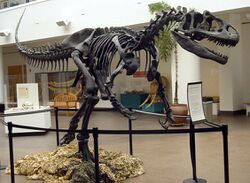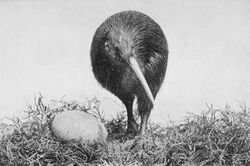Biology:Avetheropoda
| Avetheropods | |
|---|---|

| |
| Mounted Allosaurus fragilis skeleton cast, San Diego Natural History Museum | |

| |
| Kiwi with its egg (1913) | |
| Scientific classification | |
| Domain: | Eukaryota |
| Kingdom: | Animalia |
| Phylum: | Chordata |
| Clade: | Dinosauria |
| Clade: | Saurischia |
| Clade: | Theropoda |
| Clade: | Orionides |
| Clade: | Avetheropoda Paul, 1988 |
| Subgroups | |
| |
| Synonyms | |
| |
Avetheropoda, or "bird theropods", is a clade that includes carnosaurians and coelurosaurs to the exclusion of other dinosaurs.
Definition
Avetheropoda was named by Gregory S. Paul in 1988,[1] and was first defined as a clade by Currie and Padian in 1997, to include Allosaurus, modern birds, and other animals descended from their most recent ancestor. In 1999, Paul Sereno named another group, Neotetanurae, for the clade containing Allosauroidea and Coelurosauria, and excluding other tetanurans such as megalosauroids,[2] but this definition was published slightly later.
Classification
The cladogram presented below follows a phylogenetic analysis published by Zanno and Makovicky in 2013.[3]
| Orionides |
| ||||||||||||||||||||||||||||||||||||||||||
In 2019, Rauhut and Pol described Asfaltovenator vialidadi, a basal allosauroid displaying a mosaic of primitive and derived features seen within Tetanurae. Their phylogenetic analysis found traditional Megalosauroidea to represent a basal grade of carnosaurs, paraphyletic with respect to Allosauroidea.[4]
| Orionides |
| |||||||||||||||||||||||||||||||||||||||||||||||||||||||||||||||
References
- ↑ Paul, G. S. (1988). Predatory Dinosaurs of the World. New York: Simon & Schuster. ISBN 0-671-61946-2. https://archive.org/details/predatorydinosau00paul.
- ↑ Sereno, P. C. (1999). "The evolution of dinosaurs". Science 284 (5423): 2137–2147. doi:10.1126/science.284.5423.2137. PMID 10381873.
- ↑ Zanno, L. E.; Makovicky, P. J. (2013). "Neovenatorid theropods are apex predators in the Late Cretaceous of North America". Nature Communications 4: 2827. doi:10.1038/ncomms3827. PMID 24264527. Bibcode: 2013NatCo...4E2827Z.
- ↑ Rauhut, Oliver W. M.; Pol, Diego (2019-12-11). "Probable basal allosauroid from the early Middle Jurassic Cañadón Asfalto Formation of Argentina highlights phylogenetic uncertainty in tetanuran theropod dinosaurs" (in en). Scientific Reports 9 (1): 18826. doi:10.1038/s41598-019-53672-7. ISSN 2045-2322. PMID 31827108.
Wikidata ☰ Q138921 entry






